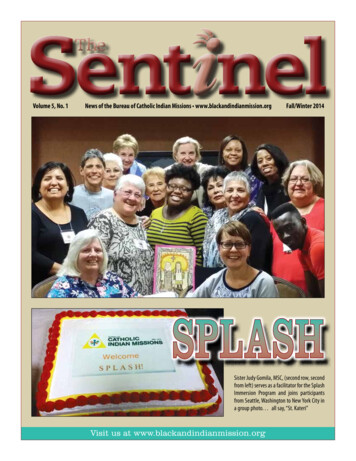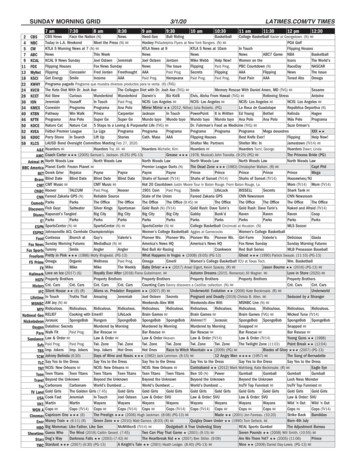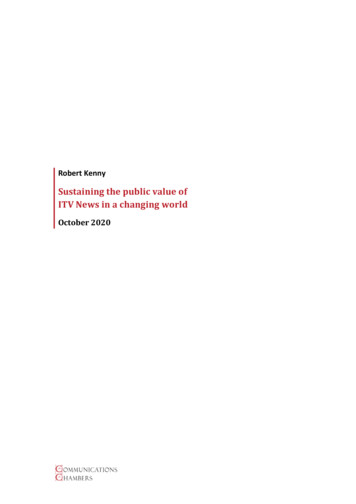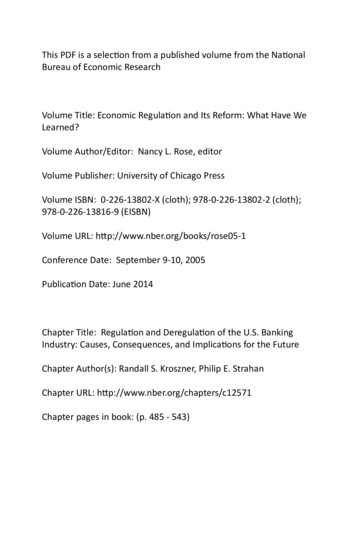
Transcription
Volume 5, No. 1News of the Bureau of Catholic Indian Missions www.blackandindianmission.orgFall/Winter 2014SPLASHSister Judy Gomila, MSC, (second row, secondfrom left) serves as a facilitator for the SplashImmersion Program and joins participantsfrom Seattle, Washington to New York City ina group photo. . . all say, “St. Kateri”Visit us at www.blackandindianmission.org
Inside this IssueNew BeginningNative AmericanMinistry in Oklahoma CityBureau ofCatholic Indian Missions2021 H Street NWWashington, DC 20006202-331-85424Circles of ianmission.orgEstablished in 1874 by theBishops of the United States2Pilgrims attendMass of Thanksgiving5MissionTo further the interestsof the Catholic Indian Missionsin the United States.Tekakwitha ConferenceFargo shines forhundreds of participantsMission LocationsAlabamaMontanaAlaskaNebraskaArizonaNew MexicoCaliforniaNew YorkColoradoNorth DakotaIdahoOklahomaLouisianaOregonKansasSouth sissippiWyomingBoard of DirectorsCardinal Timothy M. DolanArchbishop Charles J. ChaputArchbishop William E. LoriExecutive Director & EditorReverend W. Carroll PaysseManaging EditorLouis G. Aguirre6Pilgrimage of PraiseParticipants walkin Kateri’s footsteps8History of theBureauof CatholicIndian MissionsIndian SchoolsandMonsignor StephanNew Website launchedMission Office staff in Washingtonworked hard all summer to reinvigorate ourwebsite at www.blackandindianmission.org. Through a new partnership with ourgrant recipients all over the country, thewebsite will become the “go-to” placeto see up-to-date news about what’shappening in Catholic Native and AfricanAmerican communities. Check it out today!While you’re at it, follow us on Twitter (@MissionsBIMO); like us on Facebook; andtell your friends to sign up for our mailinglist at the website, too.www.blackandindianmission.org10No longerwish toreceive ourmailings?We hate to see yougo, but we will honoryour wishes if you don’twant to receive mailfrom our office. Pleasevisit www.blackandindianmission.org/unsubscribe or call our office at (202) 331-8542.
From the Executive DirectorKeeping the DreamAliveTheFall-Winter2014 issue of TheSentinelpresentsto the reader acollage of ministry,collaborationandlearning. The Bureauof Catholic IndianMissions completesthe 140th year ofevangelizationin the AmericanIndian and AlaskanNative communitiesand embarks ona new journey ofproclaiming the Gospel and building the Communityof the Church across Indian Country.It is time to dream new dreams, foster newrelationships, and raise the profile to attract ongoingsupport of the missions for the next one-hundredyears. Eleanor Roosevelt reminds us, “The futurebelongs to those who believe in the beauty of theirdreams.”There is no doubt that my predecessors met thechallenge in their own day to bring the love of Christto a people forgotten, neglected and unjustly treated.They gave their all with generous hearts of Christianservice and a conviction that with the grace of Christ,sacrifice and hard work, a better tomorrow wouldinevitably raise the profile of the very people theywere called to serve.At the same time, many, many of the faithfulacross the United States responded to the invitationto support the Indian and Alaskan Native Missions.It cannot be any different today! The Bureau ofCatholic Indian Missions needs a resurgence ofmissionary interests from the faithful and religiouscongregations to support our missions on reservationsand in urban ministry. Together, we must continue tobe the voice, the heart and the servant of our NativeAmerican and Alaskan Native sisters and brothers.Please enjoy this publication and soak in the storiesand photos of ministry, history and discipleshipas we splash into the Pueblo Indian Cultureand spirituality; meet at the summit of diocesanleadership who believe in their own baptismal callto serve and love as Jesus teaches; experience thearray of Indian Nations gathering in the Diocese ofFargo, ND for the 75th anniversary of the TekakwithaConference; accompany the Pilgrimage of Praise aswe thank Almighty God for the gift of St. Kateri, toname just a few articles to be found. I challengeall of us to search our hearts during this holy seasonand to share the faithful ministry of the Bureau ofCatholic Indian Missions with at least one otherperson, www.blackandindianmission.org.Will you promise to pray a Hail Mary each dayfor our missions, schools and urban ministry and allour missionaries? If you have not made a sacrificialoffering to support this ministry or if it has been awhile, kindly use the enclosed envelope to show yoursolidarity with our efforts. But most importantly,help us to keep the dream alive and fruitful for thosewhom we serve. I am sure you would agree, it is abeautiful dream and it is definitely worth it! With St.Paul we affirm, “I planted the seed, Apollos wateredit, only God can make it grow.” 1 Cor. 3:6Be assured of my remembrance of you andyour loved ones during the Christmas season andthroughout the New Year. Thank you.Father W. Carroll PaysseExecutive Directorwww.blackandindianmission.org3
A New Beginning for NativeAmerican Ministry in Oklahoma CityFrom Deacon RoyMy name is Deacon Roy Callison. I was born inOklahoma and have spent most of my life here. Ibelong to the Wolf Clan of the Cherokee and am amember of the Cherokee Nation of Oklahoma. I amalso a member of Redbird Ceremonial Stomp DanceGround where I served as Keeper of the Sacred Firefor several years. The Redbird ground is the oldestCherokee ceremonial dance ground in the CherokeeNation. It was established not long after my peoplecame to Oklahoma on the Trail Of Tears. I was ordained a deacon in the diocese of Tulsa, Oklahomain 2007. Shortly after ordination I was appointed asDirector of Native American Ministry for the diocese.My wife Susan and I now live in the Archdiocese ofOklahoma City. Just recently Archbishop Coakleyappointed me as Coordinator of Native AmericanCatholic Outreach for the Archdiocese. Please prayfor the success of this new Outreach and for me andmy wife, Susan.4From Susan RoyHalito!My name is Susan Callison. I am a native of Oklahoma and member of the Choctaw Nation. My husband is Deacon Roy Callison, a member of the Cherokee Nation. We have 4 children and 6 grandchildren.I enjoy ceremonial dancing and have been a memberof Red Bird Ceremonial Stomp Grounds in Southeastern Oklahoma for many years. I attended Northeastern State University where I graduated with aBachelor of Science degree in education. I worked forCherokee Nation as an early childhood teacher until my retirement. My Choctaw great grandmother,Rosa Lee Durant Buell, was the daughter of DixonDurant who founded the city of Durant, Oklahoma,the capital of the Choctaw Nation. As with many other native Americans, my ancestors journeyed up TheTrail of Tears on the way to the southwestern part ofthe Choctaw Nation in 1832. This year of the NewEvangelization in the Church, I will be assisting myhusband in the newly established Native AmericanOutreach in the Archdiocese of Oklahoma City. TheChoctaw have always believed in a single Creatorwho lived in the heavens. I am thankful this beliefhas been so enriched and made perfect through myfaith as a Catholic and the sacraments of His HolyChurch. I humbly ask for prayers that the Father,the Son and the Holy Spirit will bless and guide ourefforts. May Jesus Christ be praised in every race,tongue and nation.Deacon Roy and his wife, Susanwww.blackandindianmission.org
Pilgrims createCircles of clean waterthe Word and LiturgyBy Warren Bradyof the EucharistDiocese of Greatunder the Chair ofFalls-Billings.St. Peter.In theIn the Diocese ofdocumentary SaintGreat Falls/BillingsKateri Tekakwitha:representingSt.A Pilgimage intoLabre Indian SchoolHer Heart. The Mostin Ashland, MT,ReverendCharlesFatherMichaelJ. Chaput, O.F.M.Schneider led ourCap., Archbishop It was like bringingfor the 2012 St.the gift of the NativeKateri TekakwithaCultures into theCanonizationheart of the Church.”Mass. On our firstIn addition to manyevening in Rome,family and friends,we gathered withI’ve been able tothe entire Bureaushareexperiencesof Catholic Indianfrom our St. KateriMissions’ pilgrimageCanonizationgroup where thepilgrimage throughUnitedStatespictures and slidesEmbassy to the Holyat the St. JosephSee held a receptionCatholic Parish inin honor of the NewHysham, MT andAmericanSaintsthe Big Sky Cumon the grounds ofChristo Group inVatican City.MilesCity,MT.On October 21,This fall I had the2012thousandsprivilege of meetingpilgrimsgatheredwith the Angela’sinprayerfulPrayerful Pilgrims Gather at the “Altar of the Chair” in St. Peter’s Basilica to thank the CreatorPiazza St. Katerianticipation. Flagsfor the gift of St. Kateri. Most Reverend Charles Chaput, Archdiocese of Philadelphia wasCircle in Billings,representing manythe Main Celebrant and Bishop Emeritus of Albany, Most Reverend Howard J. Hubbard wasMT. One goal of thenations of the earththe homilist.Billings St. KateristoodthroughoutCircle is to beginSt. Peter’s Square.Following a triumphant procession, Pope Benedictagain their hospital prayer ministry. I had theXVI led the Mass of Canonization.Being inprivilege of offering St. Kateri rosaries I broughtattendance at this Mass in recognition of Sainthoodto the Canonization Mass to assist in this goal. Infor Blessed Kateri Tekakwitha and the six other holythe spirit of St. Kateri, I’m raising awareness formen and women declared Blessed by the Churchclean water related issues. For water well repair/brought immeasurable joy. Songs and words ofdevelopment in Bishop Emeritus Macram Gassis’praise filled St. Peter’s Square when all seven ofDiocese of El Obeid, Sudan in the Nuba Mountains ofthe Blesseds were recognized as Saints. Nearly 70central Sudan (www.combonimissionaries.org). Alsoyears from Venerable Kateri’s cause for sainthoodfor the St. Bonaventure Indian Mission and Schoolopened by Pope Pius XII and over thirty from Blessed(www.stbonaventuremission.org) and DIGDEEPKateri’s Beatification in 1980, we stood together asWater (www.digdeepwater.org/Navajo) in the theirshe was declared St. Kateri Tekakwitha.collective effort to develop a centralized water wellOn October 22, 2012 in St. Peter’s Basilica we hadand home-based elevated water storage systems ata Mass of Thanksgiving. In Kiowa, Comanche, andSmith Lake, New Mexico on the Eastern NavajoEnglish song and word we celebrated the Liturgy ofReservation.www.blackandindianmission.org5
Tekakwitha ConferenceFargo shines for hundreds of participants66Father W. Carroll Paysse and SisterJudy Gomilla, MSC, promoted TheSentinel during the 2014 conferencein Fargo.www.blackandindianmission.org
7www.blackandindianmission.org
Pilgrimage of PraiseParticipants walk in new saint’s footsteps8Father Paysse preaches during a Mass being offered with the pilgrims at theNational Shrine of St. Kateri, Fonda, NY.Sister Kateri Mitchell, Executive Director of the Tekakwitha Conference, sharesa few words with our pilgrims and friends during the Pilgrimage of Praise,September 2014.During a visit at St. Francis Xavier Church, Kahnawake, Canada, burial place of St.Kateri, a Mohawk tribal member plays the sacred drum and offers greater insightinto Native American spirituality.Deacon Ron Boyer, vice-postulator for the Cause of St. Kateri in Canada, providesan opportunity for the pilgrims to venerate the relic of St. Kateri.www.blackandindianmission.org
Pilgrims listen attentively as the story is retold about the miracle of the Madonna inside the first church at OurLady of the Cape, Canada.Notre Dame Du Cap, Our Lady of the Cape Shrine,Canada.9Father Henry Sands, assistant executive director of Native American Affairs, USCCB,shares a friendly chat with the pilgrims.Father Paysse points out the warm welcome the pilgrims received at the Shrine of theNorth American Martyrs.Father Paysse with his mother, Jenny Paysse, at the St. Kateri Shrine inFonda, NY during the Pilgrimage of Praise, New York and Canadawww.blackandindianmission.org
Monsignor Stephan and theIndian schools10By Tim LaniganThe late 19th Century was a time of testing forthe newly established Bureau of Catholic IndianMissions. The two principal founders of the Bureaudied within a year of each other. Brigadier GeneralCharles Ewing, the Bureau’s founding commissioner,died in mid-1883; Msgr. John Brouillet, the firstdirector, in early 1884. Both men, as recounted inthe Spring 2014 issue of theSentinel, had worked hard,over a period of ten years,to put the Bureau on a solidfooting.The two men sought andreceived a more formalrecognition of the Bureaufrom the Vatican; theyraised funds to supportthe Bureau’s offices and itsmissions; and they helpedcreate many more schoolsin the missions.It was this last effortthat created the biggestchallenge in the following17 years.At the timethe Bureau was founded,there were only threeCatholic boarding schoolsfor Indians.Ten yearslater, there were eighteen.By 1890, there were 43boarding and 17 dayschools, with the federalgovernment paying almost 400,000 to support theschools.This remarkable success was a mixed blessing. Itgave many more Indian youngsters the opportunityto learn what they needed to know to prosperin a changing world and introduced them to thefundamentals of Catholic Christianity. But at thesame time, this very successful program aroused theenvy of other Christian denominations and led to afight that pitted the Bureau’s new director againstthe new director of the federal government office thatadministered Indian Affairs.On one side was Msgr. Joseph A. Stephan, whoserved as director of the Bureau of Catholic IndianMissions from 1884 to 1901. On the other was ThomasMorgan, the federal government’s Commissioner ofIndian Affairs, brigadier general in the Civil War, aneducator, and a Baptist minister.The Fighting PriestMsgr. Stephan came to this assignment throughan unusual route. Born in 1922 in the Grand Duchyof Baden, in the south-western region of present-dayGermany, he had worked as a carpenter and lateras a military officer, beforestudying civil engineeringand later philology at twoschools in Germany.While studying ing to Kevin Abingof Marquette University,“Stephan turned to God inthis trial. He reportedlypledged to become a priestif his eyesight returned,”which it did two yearslater. He made good onhis vow, but in 1847,while studying scholasticphilosophy in preparationfor the priesthood, Stephanlearned that his father,who had emigrated to theUnited States, was dying.Leaving for the U.S. in1847, Stephan arrived intime to visit his father onelast time before he died.Stephan remained in the States, deciding to pursuehis theological studies in a seminary of the Dioceseof Cincinnati. He was ordained in 1850 and servedparishes first in Ohio and later in Indiana. Bothstates were on America’s frontier at the time, whichcalled for people who could apply a wide range ofskills in building up the new regions. Msgr. Stephanwas well prepared. As told by Abing, he was welleducated, a trained engineer, a musician, and a cook.He was an inspirational speaker, a bundle of energy,and a strong administrator, which were necessaryskills in building, and in some cases, rebuilding,parishes.Commissioned a chaplain during the Civil War, henot only ministered to the troops but alsoHistoryof theBureauof ga
helped design and build a pontoon bridge, anachievement that so impressed his superior officersthat they urged him to make a career in the military.He turned the offer down and eventually becamecommitted to the cause to which he would devotethe rest of his life, the well-being of the AmericanIndian. In 1878, while serving within the Diocese ofFort Wayne, Indiana, he applied for a position as thegovernment’s agent in the Standing Rock reservationin the Dakotas.Msgr. Stephan found the job of agent a toughassignment. He complained of dealing with themissionaries who worked at the schools and thesoldiers who manned the garrison at Fort Yates.He found the Indians to his liking, “a peaceable,industrious, and good” group, as he called them. Thewhites he accused of “harassing, backbiting, andlying,” adding he was disgusted with the place. Soit was no surprise that Stephan, an impatient manwith the temperament of a fighter, resigned from theassignment in 1881, three short years after acceptingit.But that certainly did not end his relationshipwith Indian affairs. In 1884, after serving for threeyears in parishes in the Dakotas, Msgr. Stephanwas chosen to head the Bureau of Catholic IndianMissions, replacing Msgr. Brouillet.The Conflict that Awaited HimIf Msgr. Stephan thought he had had a difficultrelationship with missionaries and soldiers atStanding Rock, he would soon find that thatassignment was sweet harmony compared to whathe would find at the Bureau’s headquarters inWashington. What awaited him was one of themost divisive issues in the nation, the government’sfunding of religiously administered contract schoolsfor American Indians.In the 1870s and 1880s, Congress simply wasn’twilling to appropriate large sums of money for thegovernment-run schools for Indians. Even by 1887,for example, these schools were educating only 10,000students out of an Indian population of 300,000.And the teaching and administrative positions at theschools were often handed out on the basis of politicalpatronage, a situation too open to incompetence andcorruption.In the mid-1870s, the government found a way tocircumvent these problems. It funded the schools,but left the staffing and administration of them toreligious and charitable groups, institutions morelikely to spend the money wisely and honestly.These schools not only offered academic training, butreligious instruction and example as well.But it was the success of the Catholic-run schoolsthat led to the program’s demise. By 1890, almosttwo-thirds of the government funding went toCatholic-run schools, a situation that dismayed thelargely Protestant national leadership of the time.The success of the Catholic schools played into thehands of American nativists, who had once recoiledat the sight of boatloads of Irish Catholics arrivingin New York harbor and Boston harbor in the 1840sand 1850s. If the nativists were upset during thisperiod, they were shocked by what followed after theCivil War.The Issue Behind the ConflictBetween 1880 and 1921, almost 24 millionimmigrants arrived in America.This was anenormous increase to the 1880 population of 50million. But it wasn’t the size of the populationshift alone that stirred emotional debates. Wheremany immigrants in the early 19th Century hadcome from such northern and western Europeancountries as Ireland and Germany, this second waveof immigration was largely from such southern andeastern European countries as Italy, Poland, andRussia. Catholics made up a large percentage of thisnew wave of immigration. In 1850 Catholics made uponly five percent of the total U.S. population. By thefirst decade of the 1900s, their numbers had arisento 14 million, or 17 percent of the total population.By then, Catholics were the largest single religiousdenomination in the country. Those politicians andeducators and writers who had long seen America aswhite, Anglo-Saxon, and Protestant were stunnedby the abrupt change in the culture, and they foughtback.The arrival of immigrants from the non-Englishspeaking, largely Catholic parts of Europe gave rise tosuch groups as the American Protective Association,an anti-Catholic society created by Protestant groupsin 1887. Among the Association’s policy objectiveswas the complete separation of Church and State.That goal included the promotion of a non-sectarianpublic school system and a prohibition of anygovernment funding of religious groups, an outcome,if enacted in public law, would have a profound effecton the education of American Indians.The case of many of those who opposed the Catholicschools was simple: Indians should be educated inpublic schools. Their argument might have beensummed up like this: The more people are like eachother, the more peaceful society will be. Americahas had an identity, one that is white, Anglo-Saxon,and Protestant. That identity should be passed onto future generations, whether descendants of earlysettlers, new immigrants, or American Indians.Education, many thought, was the best way to handdown a common culture. In fact, early advocatesof public education often referred to public schoolsas “common schools.” Of course, back then it wasassumed that a real education would be permeatedwith Christianity. The question was: who’s version?To virtually all of the people who made publicpolicy in those days, the answer was simple: theChristianity that the Pilgrims and Puritans andAnglicans brought from England in the early 17thCentury. This identity was passed on to generationsin the 19th Century through McGuffey Readers, themost widely used textbooks ever created inwww.blackandindianmission.orga11
Indian schoolsAmerica. These readers brought students the basicskills of reading through stories, poems, and essaysthat offered moral and spiritual uplift, and that not soincidentally created an impression of a white, AngloSaxon, Protestant as the model American. The worldviews of virtually all of the late 19th Century publicfigures Msgr. Stephan worked with were no doubtinformed by these texts and others like them.12The Fighter in the Other CornerAmong the Protestant leaders was ThomasJefferson Morgan. Morgan was certainly Msgr.Stephan’s most combative and determined foe. Msgr.Stephan represented Catholic Indian schools duringfive presidential administrations, but it was duringthe presidency of Benjamin Harrison, from 1889 to1893, that the debate was most heated. It was alsoduring this administration that the general outlinesof a final resolution to the issue of governmentfunding were resolved.Harrison had been Morgan’s old commander in theCivil War. After the war he went on to become alawyer, a Presbyterian elder, and a U.S. Senator. In1888, Harrison, a Republican, was elected president.He shared a similar philosophy with Morgan andwhen it came time to appoint a new commissioner ofIndian Affairs, Harrison chose his former Civil Warsubordinate.The choice of Morgan was bound to be divisive. Hewas profoundly anti-Catholic, a zealous member ofan anti-Catholic organization, the League for theProtection of American Institutions, and was in hislater years an outspoken member of the nativistAmerican Protective Association.But Morgan’s animus toward the contract schoolswas not simply a matter of anti-Catholicism. Hisadvocacy of public education also shaped his viewsabout schools run by the Catholic Church. Hisbackground as a Baptist minister and an educatorconvinced him that the best way to pass on the “civicculture” was through public education. The civicculture he had in mind was a largely Protestantculture, as typified by the historical textbooks of thetime, which stressed the stories of the Puritan andAnglican founders of the nation. The easy equationof public education and the Protestant religion “waspart of the spirit of the age,” as Father Francis PaulPrucha, S.J., put it in his comprehensive history ofthe issue, The Churches and the Indian Schools,1888-1912.The Battle BeginsMsgr. Stephan felt he had no choice but to leadthe challenge to the nominations of Morgan andespecially the man Morgan chose as Superintendentof Indian Schools, the Reverend Daniel Dorchester.Dorchester was a Methodist clergyman and a virulentanti-Catholic, who just prior to his nomination wrotethat the Catholic Church was plotting to destroyAmerican institutions.Msgr. Stephan fought tirelessly against thenominations of Morgan and Dorchester, but to noavail. Both were confirmed by the Senate after along, drawn out struggle led by Stephan, who wassupported by such Church luminaries as JamesCardinal Gibbons, Archbishop of Baltimore andthe senior American prelate, as well as two otherarchbishops, John Ireland of St. Paul, Minnesota,and Patrick W. Riordan of San Francisco. Stephanhad cultivated many friends and allies in Congressas well. But the momentum behind the unstoppabletrend toward public education and the negative publicreaction to the arrival of so many recent immigrantshelped push the two nominations through the Senate.It was clear from Morgan’s advocacy of publiceducation and from his general dislike of theCatholic Church that he was determined to defundthe Catholic Indian contract schools. His argumentsstill resonate in battles over the proper relationshipbetween Church and State today.Morgan and his allies charged that thegovernment-supported schools violated the principleof the separation of Church and State. They arguedthat the Catholic religion was alien to America’slong-standing principles and ideals, especially theprinciple of popular democracy. This charge theysupported by accusing the American Church ofreporting to a foreign power, namely, the Pope. OneMorgan ally, the Reverend James M. King, describedAmerica’s identity this way: “Our civilization is notLatin, because God did not permit North America tobe settled and controlled by that civilization.”Msgr. Stephan and his allies responded by pointingout that Catholics staffed the Indian contractschools because of a government invitation to dojust that, largely because of its inability to staff allof them itself. He pointed out all the good work thatthe Church had done in the schools and that thegovernment didn’t have the resources to replace theschools, arguments that opponents of the contractschools readily conceded. Archbishop John BaptistSalpointe of Santa Fe, New Mexico, pointed out thatthe schools in many cases had been developed afterlong years of hard work and that to destroywww.blackandindianmission.orga
these institutions was unfair. He added, pointedly,that if given the choice between government andCatholic schools, the Indians in his archdiocesewould most certainly choose the Catholic schools.The End in SightAt the urging of some of his allies, Morgan softenedhis position somewhat, but not enough to make adifference in the long-run funding of the schools. Inthe face of numerous attacks on his proposal, and evenhis character, Morgan pointed out that he had actuallyincreased funds to contract schools, that he wouldn’tclose them suddenly, but that he had no intention ofbacking down on his overall plan of replacing suchschools with government-run institutions. The issuecame to a head in 1891 when the Protestant churchesagreed to reject government funding for their Indianschools as a way of pressuring the Catholics to dothe same. Of course, they were confident thatgovernment-run schools would emphasize the sameProtestant values that such schools had since thebeginning of the public school system.The contract schools question became a heated issueduring the 1892 presidential campaign. Harrisonlost to the man he had replaced in 1889, GroverCleveland, a Democrat, and someone who was morelikely than the Republican Harrison to curry favorwith Catholic voters. Both Morgan and Dorchesterwere replaced by Cleveland, but the Democraticvictory couldn’t reverse the trend to public education.That became more clear when Cleveland appointedDaniel Browning as Commissioner of Indian Affairsrather than reappoint the commissioner who servedin Cleveland’s first administration and who was thefavorite of the Catholic hierarchy.Msgr. Stephan continued the fight over the1890s, relying primarily on his allies in Congress.But Congress gradually defunded the contractschool program over the succeeding years, until itfinally stopped all aid in 1900. That year, WilliamA. Jones, Commissioner of Indian Affairs in theWilliam McKinley administration, wrote to Stephan,inquiring which schools he intended to close sothat Jones could transfer their students to thegovernment schools. Stephan’s reply: none of them.He was determined that none of his more than 2,000students should be deprived of a Catholic education,even though it would cost the Bureau about 150,000a year. It was a bold decision, very characteristic ofthe immigrant priest who devoted his life to servingthe well-being of Native Americans.But Msgr. Stephan’s years in Washington hadsapped his energies. In 1900, he had traveled toEurope to regain his health. After returning to theUnited States, he was attending a convention inWashington, and died very suddenly in Septemberof 1901.When he passed away, he was no doubt confidentthat his work with the American Indian schools hadnot been in vain. And with good reason. Over theyears, he had developed a friendship with one ofAmerica’s great saints, a woman who helped see to itthat the Burea u of Catholic Indian Missions wouldcontinue its work with America’s original inhabitants.But that story can await the arrival of the man whowould replace Msgr. Stephan: Monsignor William H.Ketcham.Call 202-331-8542 or visit sion.org13
SPLASHProgram isheaded to Gallup, NM in 201514The Splash Immersion Program invites benefactorsand friends to a three-four day excursion to seefirsthand the impact of the funding provided to theCatholic Indian Missions across the United States.This past Fall was the second year of the program andwe doubled our participation from the initial launch,just under twenty participants. Again, we returnedto the Archdiocese of Santa Fe, New Mexico wherewe were immersed in the Pueblo Indian culture andspirituality.The Bureau of Catholic Indian Missionsintentionally keeps the number of participants lowfor the personal immersion experience we attemptto offer those who take advantage of this rareopportunity. The participants
leadership who believe in their own baptismal call to serve and love as Jesus teaches; experience the . Cherokee Nation as an early childhood teacher un-til my retirement. My Choctaw great grandmother, Rosa Lee Durant Buell, was the daughter of Dixon Durant who founded the city of Durant, Oklahoma, the capital of the Choctaw Nation. As with .











